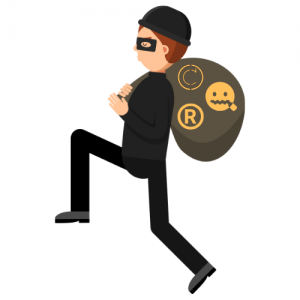docketing@steinip.com
- HOME
- > Blog Main Page
- > News
- > A Guide to Federal Intellectual Property Theft Statutes
A Guide to Federal Intellectual Property Theft Statutes
By Lauryn Bishoff
In today’s digital, globally connected economy, intellectual property (IP) is more valuable than ever. From a company’s secret formula to a musician’s copyrighted song, IP fuels society’s sense of creativity and commerce. However, with value comes risk; intellectual property can be easily stolen. While IP theft is often addressed through civil litigation, the offense can also lead to criminal prosecution.  The federal government takes these types of crimes very seriously, as such offenses can damage the reputation and business practices of the original authors and creators. Therefore, there are several federal intellectual property theft statutes that aim to deter theft of intellectual property and promote fair competition. This blog post will discuss the three main intellectual property theft statues: trade secret theft, trademark theft, and copyright theft.
The federal government takes these types of crimes very seriously, as such offenses can damage the reputation and business practices of the original authors and creators. Therefore, there are several federal intellectual property theft statutes that aim to deter theft of intellectual property and promote fair competition. This blog post will discuss the three main intellectual property theft statues: trade secret theft, trademark theft, and copyright theft.
Trade Secret Theft
The first of these is trade secret theft, which involves criminal acts carried out with the intent to use a trade secret that is related to a product or service used in commerce, for the economic benefit of anyone other than the rightful owner. [1] To receive federal criminal charges, outright intent rather than negligence or ignorance must be shown. When prosecuting this crime, the government must prove that the defendant acted intentionally and knowingly to harm the owner of the trade secret by stealing, copying, or receiving protected information without the owner's authorization. [3] Individuals who commit trade secret theft can face a $250,000 fine and up to 10 years of federal imprisonment, while business entities can face fines of up to $5 million or three times the value of the trade secret, whichever is greater. [3] When determining the severity of a criminal conviction, the court considers several factors, including the extent of harm caused, the level of leadership and planning involved, and other mitigating circumstances. For example, a defendant who led a group in stealing trade secrets worth $5 million and selling them overseas would receive a longer sentence than a defendant who stole $50,000 worth of code intending to use the code to start their own business.
Trademark Theft/Counterfeiting
The second main form of IP theft is trademark theft, also known as counterfeiting. Counterfeiting occurs when someone uses a mark that is virtually indistinguishable from one already registered with the United States Patent and Trademark Office, creating market confusion and misleading consumers, regardless of whether the defendant knew the mark was registered. [4] For trademark theft to be prosecuted by the federal government, the government must prove that there was a knowing and intentional use of a counterfeit mark in commerce, meaning the mark was used for financial or commercial gain, with the intent to deceive or harm customers. [4] Just as with trade secret theft, criminal trademark theft requires showing intent rather than ignorance. Trademark theft can also occur through the intentional use of a counterfeit military good or service, or through the use of a counterfeit mark in connection with a drug. These crimes carry serious penalties, including fines of up to $2 million for individuals ($5 million for businesses) and up to 10 years in federal prison. In cases involving serious bodily injury or death, counterfeit military goods and services, or counterfeit drugs, the penalties can become even more severe. [4]
Copyright Theft/Infringement
The last main form of IP theft is copyright theft, or copyright infringement. Infringement occurs when someone uses a copyrighted work without permission from the creator. The statute provides that to be subject to federal punishment, the government must demonstrate that (1) the copyright is valid; (2) the copyright was infringed by the defendant; (3) willfully; and (4) for purposes of commercial advantage or private financial gain. [5] The penalties for this offense include up to 5 years federal imprisonment and a $250,000 fine. For second and subsequent offenses, however, fines remain the same, but imprisonment may rise to 10 years. [1]
While there are several additional federal statutes commonly used to prosecute intellectual property (IP) theft, such as those covering economic espionage, wire fraud, and computer and internet fraud, the three discussed above most clearly reflect the government's commitment to protecting creative ideas. [2] Whether IP theft involves the unauthorized use of trade secrets, trademarks, or copyrighted materials, each instance undermines fair competition, damages consumer trust, and denies rightful owners the compensation they deserve for their work. For these reasons, addressing such crimes with the seriousness they deserve is critical.
[1] The Federal Lawyer, The Ultimate Guide to the Federal Intellectual Property Theft Statutes, https://federal-lawyer.com/the-ultimate-guide-to-the-federal-intellectual-property-theft- statutes/
[2] U.S. Department of Justice, Reporting Intellectual Property Crimes (2016), https://www.justice.gov/criminal/criminal-ccips/file/891011/dl?inline=
[3] 18 U.S.C. § 1832 (2018), https://www.law.cornell.edu/uscode/text/18/1832
[4] 18 U.S.C. § 2320 (2018), https://www.law.cornell.edu/uscode/text/18/2320
[5] Criminal Resource Manual § 1847, Criminal Copyright Infringement (17 U.S.C. § 506(a) and 18 U.S.C. § 2319), U.S. Dep’t of Just., https://www.justice.gov/archives/jm/criminal-resource-manual-1847-criminal-copyright-infringement-17-usc-506a-and-18-usc-2319.
TAGS:
RECENT POSTS
